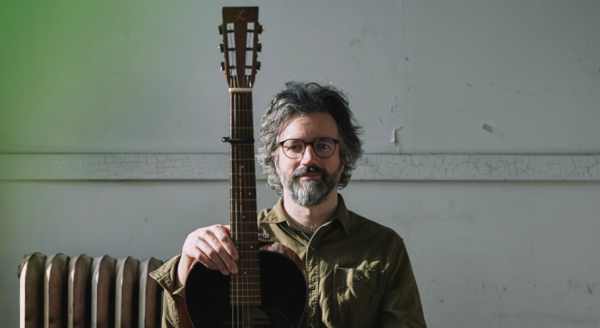

Yann Falquet
All the songs on the album are in French from the French-Canadian ballad tradition, found by Falquet mostly in books or archives. I try to avoid comparisons in reviews, but just to give an idea, the melodies and Falquet’s warm vocal and elegant guitar accompaniments sometimes remind of the solo works of France’s Gabriel Yacoub. Indeed a version of the third song, “Du long de la mer jolie” (‘Beside the beautiful sea’), a story related to the English “The maid on the shore” about a girl wittily evading the attentions of a sailor, was recorded by Gabriel and Marie Yacoub on the their album Pierre de Grenoble and again later with Malicorne. It seems to have first appeared in print in Marius Barbeau’s book Romancero du Canada in 1937; Falquet drew his version from two later sources.
A distinctive characteristic of the album is a floating, sliding feel to the accompaniments and arrangements, surrounding and giving focus to Falquet’s vocal and guitar. Robert Alan Makie’s bowed and plucked double bass enriches the sound on most tracks, joined by Robbie Kuster’s sensitive use of drum kit. In “Du Long de la Mer Jolie” there’s a lovely viola and violin part from Trent Freeman, and a kindred deep, slither-swooping one on the lamenting love-song “Les mers et les montagnes” from Quinn Bachand, who also produced and recorded the album.
That approach is taken up by Eric Vanderbilt Mathews’s clarinet in “Les îles” and, plus his bass clarinet, in “Les secrets du ciel.” “Les îles” tells of one of three boys who left France to fight far away, in ‘these infamous islands.’ and on return to Lyon finds his beloved Adèle dead and buried. “Les secrets du ciel,” is the second of two versions on the album with the same lyrics but different tunes, the other being “La belle est en prison d’amour (les secrets du ciel).” The beautiful Madeleine is wandering in the prison of love, sought by her father and her lover and seen, by a shepherd, with a bird to which she’s telling her sorrows. The lover asks the bird to tell him what she said, but it replies, ‘Ah, dear friend, forget the beauty’s secrets, let the birds tell the secrets of the sky.’ The second version has an extra verse, in which the bird tells the lover it isn’t for him that the picked rose dies, dry his tears and let the birds tell the secrets of the flowers.
The banjo of clawhammer ace Allison de Groot blends softly with the guitar in “Les secrets du ciel,” and provides a rhythmic continuo shuffle in “Les deux noyés de l’île aux Basques,” which tells of Germain and Henri, drowned in the early 1800s having set off from Île aux Basques, an island in the St Lawrence that’s nowadays a nature reserve. In the instrumental “Sutherland’s March,” composed by Falquet in honour of Vermont fiddler Pete Sutherland who died in 2022, the banjo plays the tune together with Freeman’s and Bachand’s fiddles, viola and mandolin, Makie's bass, and Falquet’s guitar and Québécois foot-percussion.
In “Le départ,” the gloomy song of a seeker for fortune longing for his family as he leaves California, there’s a new pair of slitherers: Thorleifur Gaukur Davidsson on ethereal pedal steel plus a touch of bass harmonica, and trumpet and flugelhorn from Nadje Noordhuis. The closer is “Courage,” the last message by a soldier from the Angers regiment who, having deserted for love of a woman, is about to be hanged, with violins, harmonium, organ bass pedals, and a hint of backing vocal from Julia Friend.
Further reading and listening:
Search RootsWorld
|